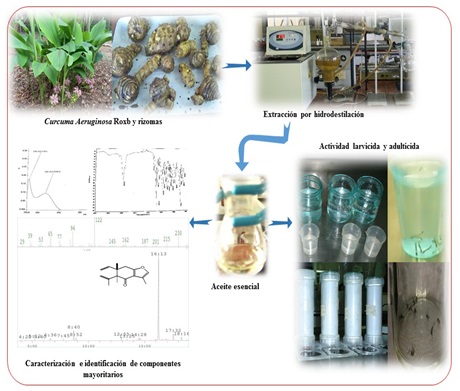Chemical composition and insecticidal activity against mosquitoes of the essential oil of Curcuma aeruginosa Roxb
Keywords:
Curcuma aeruginosa; essential oil; curzerenone; larvicidal activity; adulticidal activity.Abstract
In order to develop natural alternatives to control mosquitoes of medical importance, the chemical composition and insecticidal activity of the essential oil of the rhizomes of Curcuma aeruginosa Roxb were evaluated. The oil was characterized by its organoleptic, physical-chemical properties and ultraviolet and infrared spectra. The quantification of the oil components was carried out by gas chromatography and the major ones were identified by mass spectrometry; Curzerenone was the most abundant component. The insecticidal activity was evaluated in populations of Aedes aegypti, Aedes albopictus and Culex quinquefasciatus using methodologies standardized by the World Health Organization. The oil maintained an homogeneous response against the three mosquito populations, showing significant larvicidal and adulticidal activities. It constitutes the first report of the chemical composition of the essential oil of C. aeruginosa cultivated in the eastern Cuban region and the bioassays conducted demonstrated its insecticidal potential as an ecological alternative.
References
MARÍN, R. M., et al. “Estudio químico y potencialidades biológicas de especies vegetales que crecen en Cuba”. Anales de la Academia de Ciencias de Cuba. 2020; 11 (1): 901. ISSN: 2304-0106.
AHMED, R. H.; MUSTAFA, D. E.; MOHAMED, Y. S. “Anti-diabetic Plants used in Sudanese Folk Medicine and their Phytochemical Constituents”. Journal of Advanced Research in Pharmaceutical Sciences & Pharmacology Interventions. 2019, 3 (1): 3-6. ISSN:2455-6998.
HARTATI, F. K.; KURNIA, D.; NAFISAH, W.; HARYANTO, I. B. “Potential anticancer agents of Curcuma aeruginosa-based kombucha: In vitro and in silico study”. Food Chemistry Advances. 2024, 4, 100606. https://doi.org/10.1016/j.focha.2024.100606
YUANDANI et al. “Antibacterial, bacteriolytic, antibiofilm, and synergistic effects of Curcuma species ethanol extracts with antibiotic against multidrug resistant Pseudomonas aeruginosa”. J. Herbmed. Pharmacol. 2024; 13 (1): 153-162. https://doi.org:10.34172/jhp.2024.48295
AKARCHARIYA, N.; SIRILUN, S.; JULSRIGIVAL, J.; CHANSAKAOWA, S. “Chemical profiling and antimicrobial activity of essential oil from Curcuma aeruginosa Roxb., Curcuma glans K. Larsen & J. Mood and Curcuma cf. xanthorrhiza Roxb. collected in Thailand”. Asian. Pac. J. Trop. Biomed. 2017, 7 (10): 881-885. ISSN: 2588-9222.
RAHAMAN, M. M. et al. “The Genus Curcuma and Inflammation: Overview of the Pharmacological Perspectives”. Plants. 2021, 10(63): 2-19 https://doi.org/10.3390/plants10010063
ALI, A.; WANG, Y. H.; KHAN, I. “Larvicidal and biting deterrent activity of essential oils of Curcuma longa, Ar-turmerone, and Curcuminoids against Aedes aegypti and Anopheles quadrimaculatus (Culicidae: Diptera)”. J. Med. Entomol. 2015, 52 (5): 979–986. https://doi.org/10.1093/jme/tjv072
LEYVA, M. et al. “Plantas con actividad insecticida: una alternativa natural contra mosquitos. Estado actual de la temática en la región de las Américas”. Rev. Biomed. 2017, 28: 139-181. https://doi.org/10.32776/revbiomed.v28i3.571
ANDRADE-OCHOA S. et al. “Aceites esenciales y sus componentes como una alternativa en el control de mosquitos vectores de enfermedades”. Biomédica. 2017, 37 (Supl.2): 224-43. https://doi.org/10.7705/biomedica.v34i2.3475
DOSOKY, N. S. y SETZER, W. N. “Chemical Composition and Biological Activities of Essential Oils of Curcuma Species”. Nutrients. 2018; 10: 1196. ISSN 2072-6643.
ELHAWARY, E. A.; MOUSSA, A. Y; SINGAB, A. N. “Genus Curcuma: chemical and ethnopharmacological role in aging process”. BMC Complementary Medicine and Therapies. 2024, 24:31. https://doi.org/10.1186/s12906-023-04317-w
MINSAP. Medicamentos de origen vegetal: Droga cruda. Métodos de ensayos. NRSP 309. La Habana, 1991.
MINSAP. Medicamentos de origen vegetal. Extractos fluidos y tinturas. Métodos de ensayo. NRSP 312. La Habana, 1992
WHO. Guidelines for laboratory and field testing of mosquito larvicides. WHO/CDS/WHOPES/GCDPP/Ginebra,2005.13. Disponible en: https://www.who.int/publications/i/item/WHO-CDS-WHOPES-GCDPP-2005.13
CDC. Centers for Disease Control and Prevention (2010). Guideline for Evaluating Insecticide Resistance in arthropods vectors using the CDC bottle bioassay. Atlanta, GA. Disponible en: https://www.cdc.gov/malaria/resources/pdf/fsp/ir_manual/ir_cdc_bioas-say_en.pdf
ORGANIZACIÓN MUNDIAL DE LA SALUD. Prueba OMS de susceptibilidad para mosquitos adultos. En: Procedimientos de las pruebas para la vigilancia de la resistencia a los insecticidas en los mosquitos vectores del paludismo. 2da Ed. OMS Press. Ginebra, Suiza. 2017. ISBN 978-92-4-351157-3
OANH, P. T. et al. “The rhizome essential oil of Curcuma aeruginosa Roxb. (Zingiberaceae) from Vietnam”. Trends Phytochem. Res. 2018, 2 (3):179–84. ISSN: 2588-3631.
ARIAS CEDEÑO, Q. et al. “Characterization of the Curcuma longa L. essential oil and its insecticidal activity against Aedes aegypti”. Revista Cubana de Química, 2020; 32 (3), 378-389. e-ISSN: 2224-5421.
BARRADAS, T. N.; DE HOLANDA E SILVA, K. G. “Nanoemulsions of essential oils to improve solubility, stability and permeability: a review”. Environ. Chem. Lett. 2021, 19: 1153–1171. https://doi.org/10.1007/s10311-020-01142-2
CHÁVEZ FERNÁNDEZ, J.; LIZÁRRAGA LAZO, V.; VARGAS DE NIETO, E. “Caracterización físico química de los componentes volátiles del Tecoma fulva subsp. Arequipensis (cahuato)”. Rev. Soc. Quím. Perú. 2020, 86(3), 246-259 Disponible en: http://www.scielo.org.pe/pdf/rsqp/v86n3/2309-8740-rsqp-86-03-246.pdf
THEANPHONG, O.; MINGVANISH, W.; KIRDMANEE, C. “Chemical constituents and biological activities of essential oil from Curcuma aeruginosa Roxb. Rhizome. BHST. 2015, 13 (1), 06-16. ISSN: 0858-7531.
LEYVA-SILVA, M. I. Actividad insecticida de aceites esenciales sobre vectores de importancia médica Aedes aegypti, Aedes albopictus y Culex quinquefasciatus (Diptera: Culicidae). La Habana 2012-2017. Tesis de doctorado en Ciencias de la Salud. Instituto de Medicina Tropical “Pedro Kourí”, La Habana, 2019. [Fecha de consulta: 3 diciembre 2023] Disponible en: https://tesis.sld.cu/index.php/index.php?P=FullRecord&ID=85
ZHENG, T. et al. “Anticancer effects of curzerenone against drug-resistant human lung carcinoma cells are mediated via programmed cell death, loss of mitochondrial membrane potential, ROS, and blocking the ERK/MAPK and NF-κB signaling pathway” JBUON. 2019, 24 (3): 907-912. ISSN: 1107-0625
LIM, H.; LEE, S. Y.; HO, L. Y.; SIT, N. W. “Mosquito Larvicidal Activity and Cytotoxicity of the Extracts of Aromatic Plants from Malaysia”. Insects. 2023, 14: 512-530. Disponible en: https://www.mdpi.com/2075-4450/14/6/512
AUNGTIKUN, J. y SOONWERA, M. “Improved adulticidal activity against Aedes aegypti (L.) and Aedes albopictus (Skuse) from synergy between Cinnamomum spp. essential oils”. Scientific. Reports. 2021, 11: 4685-4697. https://doi.org/10.1038/s41598-021-84159-z

Downloads
Published
How to Cite
Issue
Section
License
Copyright (c) 2024 Quirino Arias-Cedeño, Maureen Leyva-Silva, Pedro L. Guevara-Blanco, Lázaro E. Valdés-Izaguirre, Peter- Langer

This work is licensed under a Creative Commons Attribution-NonCommercial-NoDerivatives 4.0 International License.
This journal provides immediate open access to its content, based on the principle that offering the public free access to research helps a greater global exchange of knowledge. Each author is responsible for the content of each of their articles.






















